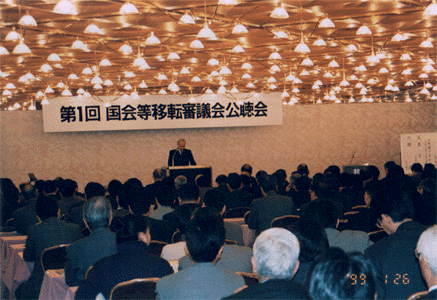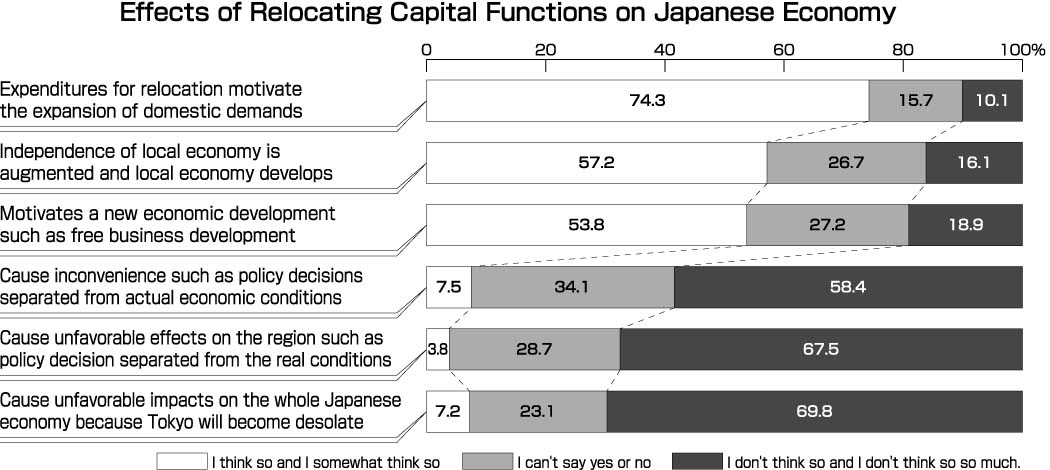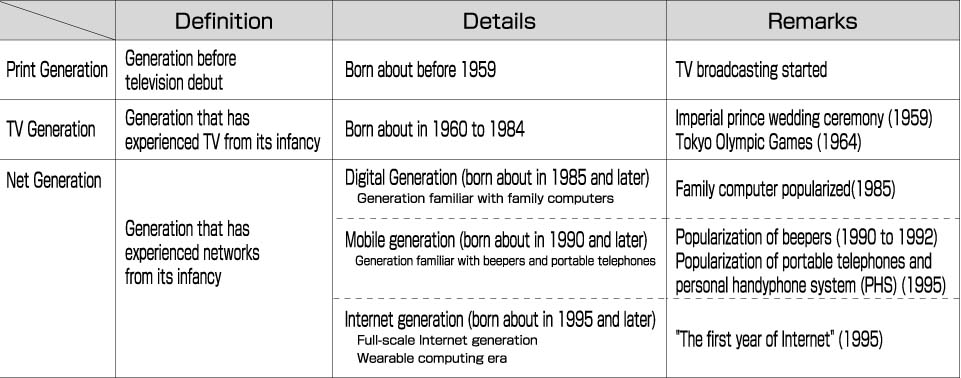

| Public Hearings Being Held |
The Council for Relocation of the Diet and Other Organizations
plans to hold public hearings with
participation by members and expert members of the Council in nine regions around
the country to
listen to opinions of a wide range of citizens to contribute to building up
a national consensus as
well as to reflect those opinions in future deliberations and report conclusion
in the Council.
=Hearings Held in Osaka and Nagoya
 |
The first public hearing was held on January 26 in Osaka,and the second on February 1 in Nagoya. At each hearing,more than 200 persons participated. In those hearings,a wide range of opinions,both pro and con,were expressed by eight people chosen by lot; Opinions and impressions were also presented by other participants on a voluntary entry basis. Take a look at the proceedings of the hearings on the National Land Agency homepages on Internet! |
Future Hearing Schedules and Procedures for Participation
Miyagi Daiichi Hotel at 2-45, Tsutsujigaoka 1-chome, Miyagino-ku, Sendai, Miyagi Prefecture April 14 (Wednesday) from 14:00 to 16:00 Hiroshima Garden Palace at 15, Hikari-cho 1-chome, Higashi-ku, Hiroshima, Hiroshima Prefecture April 26 (Monday) from 14:00 to 16:00 |
(Reference)
And detailed hearing schedules after May 1999 will be announced later.) |
| - | Those who would like to participate in the hearings for
both the Miyagi and Hiroshima Meetings should apply by mail or fax clearly
describing their address, name, age, telephone number, desired place of
hearing by the following closing dates (for sending address, refer to the
end of this issue): By March 26, 1999 (Friday) for the Hiroshima Meeting |
| - | If there are too many applicants, admission tickets will be sent to people selected by lot (announcement will be given to those who can't get the tickets). |
| - | Those who would like to make a statement should write
clearly "Statement Desired" and summarize the statement (about
eight minutes will be allowed for each statement. If too many people desire
to speak, the Council will select speakers by lot in advance. The result
of the selection will be informed to each applicants). |
| Recent Deliberation Status of the Council for the Relocation of the Diet and Other Organizations |
The Council is promoting investigation and study in many fields
such as topography, landscape,
water supply, earthquake and other disasters to select candidate relocation
sites for the Diet and
other organizations.
Recent Council deliberations on three themes are summarized here.
(1)Study on Remedial Effects on the Unipolar Concentration
of Activities in Tokyo
Analysis of questionnaires on the effects of the relocation
on the unipolar concentration of
activities in Tokyo sent out to about 10,000 enterprises around the country
revealed the
following opinions:
(a) Even though the capital functions are relocated, economic appeal of Tokyo will not change
so much.
(b) Many enterprises deem that the relocation will favorably affect the Japanese economy
(refer to the figure below).(c) Few enterprises will relocate their headquarters or business bases to the new city

An estimation made to understand the approximate population change of the metropolitan
region for reference revealed that the population of the metropolitan region
would be reduced by
hundreds of thousands ten years after the capital functions relocation starts
because the
residents other than just government officials will exit Tokyo.
(2)Study on Information Network
The era when the new city functions are mainly run by the "net
generation" (the generation
that has experienced the information network since its infancy) is rapidly approaching.
This
generation will not only passively obtain information in front of a personal
computer but will also
actively meet other persons or go out to the streets to confirm the obtained
information or
getting new intellectual stimuli (network + footwork >> "nefootwork"
type).
Therefore, the relocation site for a 21st century information city should be
near a mother city
or a province center city equipped with the infrastructure to meet such behavioral
desires but also
a region with a sense of distance which is not restricted by the existing city
infrastructures.

| HOME | NEXT |